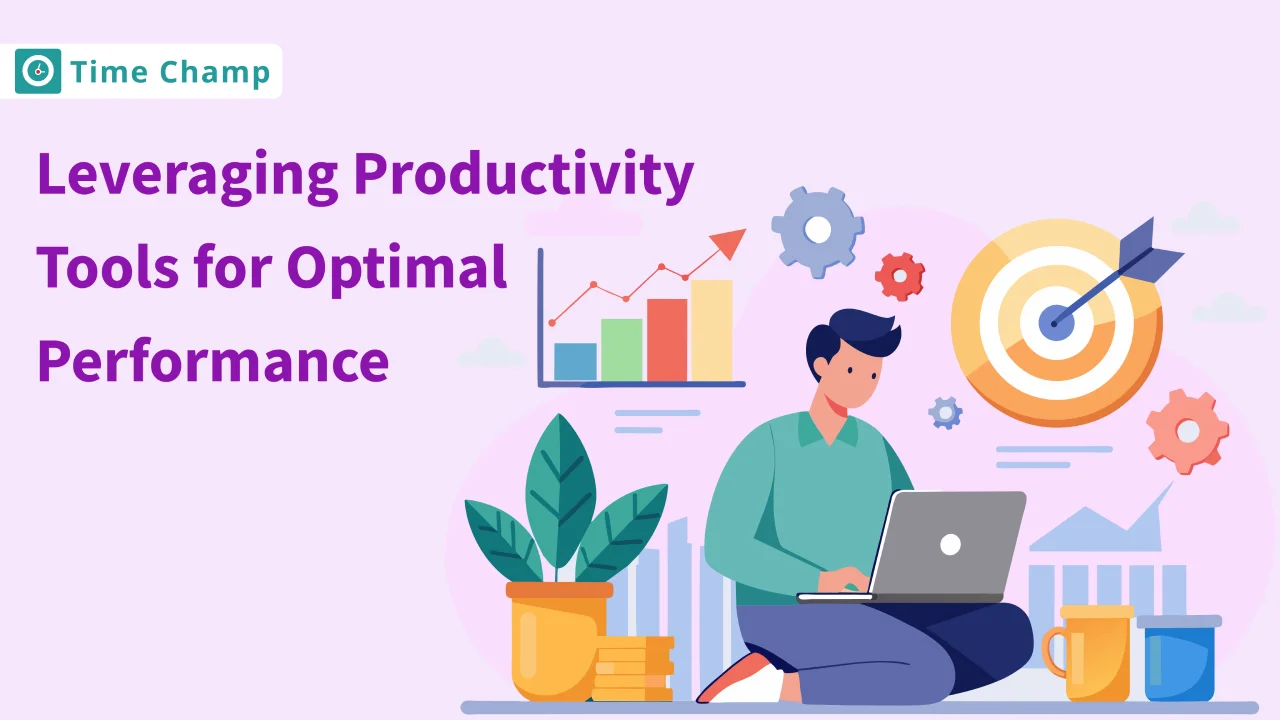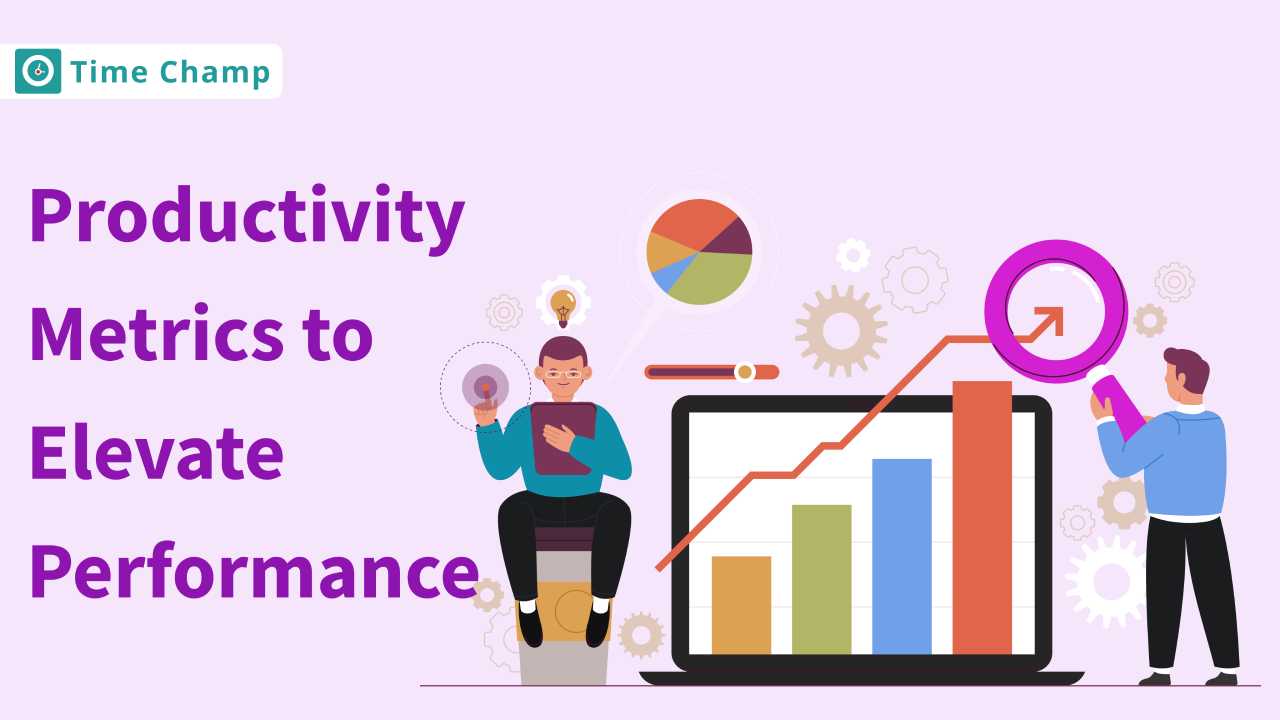Now, in an era when business operations are increasingly dominated by technology, for any organization to be successful we must understand and can improve employee productivity. Not only does gratifying productivity promote business growth, but it also contributes to a healthier and more motivated staff. Teardown This all-encompassing handbook hopes to decipher the mystery of what employee productivity is, explain its significance in the workplace, and examine a variety of methods that can help devise ways to monitor efficiency and boost productivity in teams working from home.
But don’t neglect to streamline your operations and improve time management. Go give Time Champ a shot!
Introduction to Employee Productivity:
1. What Does Employee Productivity Mean?
The efficiency with which an individual or team turns inputs, such as time and effort, into valuable outputs like goods and services is the essence of employee productivity. Optimizing the use of these resources is key to productivity in the workplace. It’s not only about how much is produced–it’s also a measure of how smartly and sustainably this is done.
2. In the Workplace, Why is Productivity so Important?
The power of productivity in the workplace cannot be exaggerated. It’s a keystone in operational excellence, cost-cutting, quality improvement, and customer satisfaction. A productive workforce can meet clients’ needs quickly, and creatively. However, promoting a culture of productivity is also a major retainer. After all, people like to be on an effective team and will take pride in their accomplishments.
Employee Productivity Tools: The Modern Enablers
Technology provides us with a seemingly limitless treasure chest of tools to further performance. Employee productivity tools are software programs that help people manage their time, organize tasks, and communicate more efficiently at work. From time-lost productivity trackers to team collaboration platforms, these tools are changing the face of the modern office.
1. Productivity Measurement Software
The first step in managing and enhancing productivity is to measure it. Work patterns can be analyzed by productivity measurement software, time allocation tracked, and areas for improvement indicated. Some software not only tracks but also offers suggestions on how to increase productivity even further. For managers looking to improve their team’s efficiency, real-time data and analytics are priceless.
2. Operations Management Productivity and Efficiency
For sustainable growth, productive and effective operations management is necessary. This requires a focused effort to simplify procedures, cut repetition, and improve the quality of outcomes. Working to this end are tools that aid workflow automation, digital process mapping, and lean management. These resources help to establish a transparent, efficiency-based strategy that employees can easily grasp.
And that’s the end of Batch There are still more insights to come as we take a closer look at detailed tools and strategies for productivity improvement, from remote productivity monitoring tools to productivity trackers.
Continue Reading: Remote Team Productivity and Workforce Services
3. Remote Productivity Monitoring Tools
Though remote work allows greater flexibility, it can often make monitoring productivity difficult. However, the solution to making sure team members are managing their time and staying on task is remote productivity monitoring tools. Such tools are usually equipped with activity monitoring, screenshot capture, and time spent on certain applications or websites. But if these tools are used transparently and with trust so as not to violate employees ‘privacy, it’s important.
Case Study: Enhancing Remote Team Productivity
Remote teams are often spread across various time zones and regions in a global market. Tools such as Time Champ, which monitors the work being done, can help coordinate efforts and divide up responsibility. The aim is to increase productivity with due regard to the work-life balance that remote working is supposed to offer. These tools give managers a clear understanding of working patterns, allowing them to work with their teams on fine-tuning performance.
4. Productivity Tracker: Keeping Tabs On Workflows
The productivity tracker is a more precise instrument that the user can use to record and analyze his or her working methods. These trackers are priceless tools for self-improvement because they make it easier for employees to do their audits and work harder. In this way, gradually appearing schedule patterns make obvious the peak productivity periods, common interruptions, and bottlenecks in workflow. Thus begins a more scientifically chosen time for working thereafter.
5. Work Productivity Tracker: A Personal Audit
Work productivity trackers are the other big category of time and task managers. They adapt tracking to suit particular job roles or industries. For instance, creative professionals could focus on project completion percentages, while customer service positions would keep a count of tickets resolved. Understanding the individual requirements of different positions ensures that the right metrics are applied to assess and stimulate employee productivity.
Productivity Improvement in Operations Management:
The Pillars of Productivity
Productivity improvement is a strategic goal in operations management, and achieving it rests on several pillars:
- Alignment of Goals: Having individual, team, and organizational objectives running in a parallel direction makes for uniform productivity improvement.
- Resource Optimization: Environmentally sustainable productivity growth requires optimal utilization of resources, be they human capital, technology, or materials.
- Process Enhancements: The methodologies of Six Sigma or Kaizen for continually improving operational processes can achieve massive productivity increases.
Adopting Efficiency and Productivity Tools:
An important thing that an organization can do is to select workforce productivity tools that integrate neatly with existing procedures. These should be tools that promote cooperation, time management, and task distribution, the foundations of a productive work environment. Don’t forget to look at Time Champ for a one-stop shop for many of these productivity needs.
Harnessing Productivity Tools: A Closer Look
The Right Tools for a Boost in Productivity
Choosing the right tools for your team means impressive increases in efficiency. Here are some examples of productivity tools for employees:
1. Task Management Software: Asana or Trello are examples of tools that teams can use to organize tasks and decide what needs doing and when it is due, in a collaborative and fun work environment.
2. Communication Platforms: Slack and Microsoft Teams offer team chat functions that allow us to cut down on the amount of email we receive and ensure better real-time communications.
3. Document Collaboration: The live document editing capabilities of Google Workspace and Office 365 help solve the problem of individual creeping file versions, and promote collaboration among users.
Overcoming Resistance to New Tools:
New productivity tools sometimes meet with resistance, but as long as they are well-trained and employees see the benefits for themselves, there is little resistance. We must emphasize how such tools can help make their work more convenient, faster, and rewarding.
At this point, batch 2 finishes. The following section will introduce methods to improve work efficiency, actual examples of productivity tools, and how to trace and raise remote team productivity.
Ways to Increase the Productivity of Remote Teams:
That’s not to say, however, that working remotely leads to lower productivity. If the right plans and mechanisms can be set up, remote teams will be as effective, if not more so than office-based ones.
1. Establish Clear Communication Channels
Communication must be clear and consistent to make remote work succeed. Set up separate communication channels for different modes of interaction– urgent needs; long-term projects; and casual contacts. Such tools as Slack or Microsoft Teams help team members connect seamlessly in a virtual office space.
2. Regular Check-ins and Updates
Regular check-ins allow members of remote teams to report on progress, voice concerns and receive feedback. It promotes a feeling of solidarity and ensures that everyone is working toward the team’s objectives.
3. Foster a Results-Oriented Culture
In remote regions, where monitoring is difficult, concentrate on outcomes rather than functions. Condemn a culture where being busy is more important than quality and deadlines.
4. Invest in Training
Make sure your team knows how to use productivity tools. Confidence and competence in using these digital enablers will be enhanced by training sessions, webinars, and tutorial resources.
Productivity Tools for Modern Workforces:
With so many productivity tools to explore, who has time? To simplify, here’s a rundown of must-have categories for a well-equipped remote team:
1. Remote Productivity Monitoring Tools: To monitor how work hours are being spent without invading privacy, consider techniques like those used by Time Doctor or TimeChamp
2. Productivity Trackers and Analyzers: Tools such as RescueTime provide information on individual work styles. They also help employees monitor their productivity levels.
3. Project Management Software: With Asana, Trello, or Jira, projects become easier to manage with organized task lists, timelines, and collaborative features.
The right mix of productivity tools depends on your team’s nature and scope of work.
Measuring Productivity: Software and Metrics
But it’s not enough to use productivity tools–organizations need to monitor the results. Knowing which metrics to track is vital:
1· Output Per Hour: Compare the amount of work done to time spent.
2· Project Completion Rates: Assess the proportion of projects completed on schedule.
3· Task Efficiency: Watch how quickly and easily the tasks are done.
Here we turn to productivity measurement software, which tracks automatically and produces actionable reports that can provide clues for future decisions and improvements.
Time Champ: A Comprehensive Productivity Tracking and Management Software
Time Champ is a cutting-edge, all-in-one productivity tracking and management solution that measures, monitors, and improves the performance and productivity of every department, team, and employee in an organization. It is based on an automated approach and provides for personalized productivity evaluation, allowing businesses to reliably plan for growth and operational efficiency.
Time Champ’s Key Productivity Management Features:
- Monitoring of Application and Website Usage: Time Champ gives detailed insights by recording all applications and websites used by employees during work hours. This granular tracking includes application names and window titles, providing accurate data for analysis.
- Customized Productivity Reports: The program can generate reports indicating how long each team member spends using each application. The reports show productive, non-productive, and neutral program utilization, allowing managers to discover areas that need attention or resource reallocation.
- Productivity Definition Customisation: The platform allows for customization at the individual, team, and business levels, to fit with unique productivity definitions based on job descriptions, departmental requirements, and broader organizational goals.
- Delineation of Productive and Non-Productive Components: In accordance with their company’s regulations, users can mark programs or websites as productive, non-productive, or neutral. This classification is essential for producing appropriate productivity numbers.
- Productivity Data Visualisation: Time Champ offers data in a user-friendly format, such as doughnut charts and heat maps that indicate productivity activity across days, weeks, or months. These graphic representations aid in the rapid evaluation of staff performance patterns.
- Productive Activity Breakdown: Managers can view a detailed breakdown of their employees’ working hours, separating productive, non-productive, and neutral time. Time Champ also captures time away from the employee to account for moments when he or she is offline or idle.
Time Champ is developed to streamline the productivity management process in a way that is both comprehensive and flexible to the individual demands and structure of each organization, with a focus on transparency and efficiency. It is a key tool for businesses looking to optimize their operations and foster a results-oriented culture in today’s technologically driven workplace.
Time Champ is not only limited to productivity tracking but also encompasses advanced features, enabling robust employee monitoring, detailed task and project management, alongside live recording capabilities. It facilitates precise location tracking, and streamlined time tracking, and integrates HR functionalities such as automatic attendance and leave management, making it an all-in-one solution for optimizing operational efficiency across various aspects of the modern workplace.
With Time Champ, embark on a journey to increase your team’s efficiency and find your workforce’s full potential. Don’t just take our word for it—book a personalized demo today to see for yourself how Time Champ boosts productivity in your organization.
Conclusion:
Empowering Productivity Through Technology
Bottom Line–boosting employee productivity is a long trek, the key to any company’s health and vitality. Now equipped with a powerful arsenal of productivity tools, all tailor-made to aid operation, measure the results, and encourage cooperation, businesses are better able than ever before to survive in this jungle.
Whether it’s remote workforce supervision or internal improvement, technology is only a tool. The key lies in the human element-the welfare of your team.
If you’re going to move forward to improve your company’s productivity, throw some tools like Time Champ into the mix and see what you can do with them. Their solutions cover all the bases, helping your team become more productive and efficient without sacrificing sustainability or morale.
We hope this thorough guide has given you the information and tools to take your team’s productivity even higher. Technology will take you to exceptional performance and operational excellence. Embrace the change, and commit to continuous improvement.







